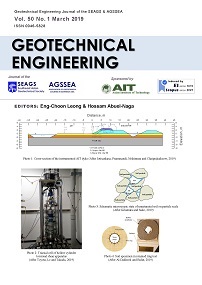Interpretation of Desiccation Soil Cracking in the Framework of Unsaturated Soil Mechanics
Main Article Content
Abstract
Cracks evolve in expansive soils when subjected to drying and shrinkage processes. The underlining driving mechanism is the development of the tensile stress in perpendicular direction to the crack length. The tensile stresses are generated from the restrictions applied on the soil from shrinking freely. When the tensile stress exceeds the soil tensile strength, cracks initiate and propagate. The soil shrinkage, generated tensile stress, and tensile strength are governed by the effective stress regime existing in the soil microspores. All these mechanisms require the tracking of the soil cracking phenomenon from the internal stresses developed in the microspores system. Understanding the stresses that are developed in the soil microspores system is a challenging task. It is mainly due to the complexity of the physicochemical interactions taking place in the soil pores. This paper presents understanding and modelling the soil cracking by relying on unsaturated soil mechanics. Based on the laboratory results from desiccating expansive soils subjected to restricted shrinkage, this paper demonstrates that the crack growth in soils occurs mostly in the unsaturated condition for initially saturated soils. Restricted shrinkage tests are carried out using restrained ring testing method to induce cracks in the soil specimens. The results demonstrate that a crack for initially saturated soils first initiates at suction close to the air-entry value. Free shrinkage tests are also conducted to predict the soil shrinkage curve. The results from restrained ring tests are explained in terms of the soil-water characteristic curve and soil shrinkage curve.
Article Details

This work is licensed under a Creative Commons Attribution-NonCommercial-NoDerivatives 4.0 International License.
Copyright © 2019 Association of Geotechnical Societies in Southeast Asia (AGSSEA) - Southeast Asian Geotechnical Society (SEAGS).


